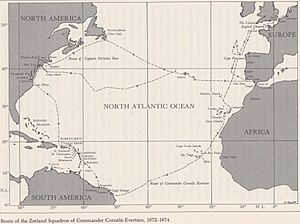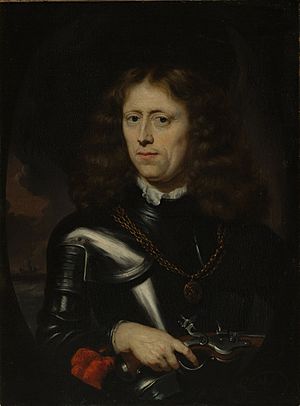Dutch Raid on North America facts for kids
Quick facts for kids Dutch Raid on North America |
|||||||
|---|---|---|---|---|---|---|---|
| Part of Franco-Dutch War and Third Anglo-Dutch War | |||||||
 |
|||||||
|
|||||||
| Belligerents | |||||||
| Commanders and leaders | |||||||
| Strength | |||||||
| Initially 6 vessels (115 guns) and 586 men | Munden's Squadron 4 warships (174-184 guns) 2 fireships |
||||||
| Casualties and losses | |||||||
| 200-650 vessels captured or destroyed | |||||||
The Dutch Raid on North America was a naval attack by the Dutch on English and French colonies. It happened between December 1672 and February 1674. This raid was part of the Third Anglo-Dutch War, which was connected to the bigger Franco-Dutch War.
A Dutch admiral named Cornelis Evertsen the Youngest led this sea trip. He was helped by Jacob Binckes. They attacked places controlled by England and France in North America. They even took back the old Dutch colony of New Netherland. However, this land was given back to England later. This happened because of a peace deal called the Treaty of Westminster (1674). This raid was the last time the Dutch had a direct impact on colonies in North America.
Evertsen first planned to attack English trading ships. But his ships were stopped by a stronger English fleet. So, he changed his plan and headed for the Americas. There, he joined up with another Dutch fleet led by Binckes. What started as a raid to cause damage and make money turned into a mission to take back lost lands.
Contents
Why Did the Raid Happen?
England and the Dutch Republic had fought two wars before (1652-1654 and 1665-1667). But after 1667, things got calmer between them. Both countries were worried about France, led by Louis XIV of France, growing too powerful. Also, the Dutch traded their colony of New Amsterdam for a spice island called Run. This solved a big disagreement.
However, in 1670, King Charles II of England secretly agreed to help France attack the Dutch. This led to the Third Anglo-Dutch War in April 1672.
When France invaded the Dutch Republic in May 1672, it looked like France would win easily. But the Dutch stopped the French by flooding their own land. This was called the Dutch Waterline. The Dutch needed to control the sea to get supplies and keep trade going. In June 1672, the Dutch navy fought the English and French navies at the Battle of Solebay. This battle stopped the English and French from landing troops on the Dutch coast.
France's success worried other countries. The Dutch got support from places like the Holy Roman Empire and Spain. Many people in England also didn't like being allied with Catholic France. Peace talks failed because Louis XIV made demands that even his English allies thought were too much.
By late 1672, the Dutch province of Zeeland was running out of money. They needed a lot of cash to keep going. So, leaders like Pieter de Huybert and Justus de Huybert came up with a plan. They decided to try and capture rich English trading ships. If that failed, they would attack French and English colonies in the Americas. The Admiralty of Zeeland secretly prepared for this trip. They chose the skilled admiral Cornelis Evertsen the Youngest to lead a fleet of 6 ships and 586 men.
The Journey Begins
Across the Atlantic

On November 30, 1672, Evertsen's fleet left Vlissingen. He carefully sailed through the narrow Strait of Dover. The next day, after meeting only one English warship, Evertsen entered the Atlantic Ocean. He captured a few English ships along the way.
After some bad weather, Evertsen reached the Canary Islands on January 14. He restocked his supplies there. Then he sailed to the Portuguese Cape Verde Islands. On February 8, while getting supplies in Santiago Bay, he was surprised. A stronger English fleet, led by Richard Munden, attacked him. Munden was actually there to stop Dutch trading ships.
The Dutch quickly pulled up their anchors and threw things overboard to lighten their ships. This helped them sail faster than the English. Evertsen's quick thinking and his crew's skill helped them escape. But their ships were still trapped in the bay. The next day, Munden asked Evertsen to surrender. He threatened to use a fire ship to burn them. Evertsen replied that he and his crew would "defend our ships to the last man." Again, Evertsen managed to outsmart the English and sail his ships to safety.
After this close call, Evertsen knew he couldn't complete his first mission. He didn't want to return home without achieving anything. So, Evertsen decided to sail for America instead.
In the Caribbean

Evertsen first went to The Guianas. He thought about capturing the French colony of Cayenne but decided against it. He then sailed to Suriname, which was already controlled by the Dutch. Next, Evertsen headed for the French colony of Martinique.
While sailing near Martinique, he met another Dutch fleet by chance. This fleet had six ships from Amsterdam and was led by Jacob Binckes. Binckes had arrived earlier and had already captured some French ships. They decided to team up. They agreed to take turns leading the combined fleet each week. Their plan was to attack both English and French colonies. Their first target was the French colony of Guadeloupe.
When they arrived, two French armed merchant ships attacked them. The Dutch easily defeated them. After laying siege to Guadeloupe, they captured five more armed merchant ships. They then tried to take Nevis but failed due to poor communication.
They continued to the Leeward Islands, with Saint Kitts as their next stop. On May 28, they arrived off its west coast. They bothered and captured ships anchored there. The old Dutch colony of Sint Eustatius was nearby. The English had captured it recently, and Evertsen wanted to take it back. On May 29, they arrived. After a short fight, the English soldiers gave up. The Dutch captured the island and nearby Saba.
The Dutch fleet stayed there for a while, capturing more ships and taking enslaved Africans. They then sailed to the neutral Spanish island of Puerto Rico. They planned to sell the enslaved people they had captured from the English. But the Spanish governor in San Juan was not helpful. He kept delaying and refused to let them get supplies.
In San Juan, the Dutch commanders thought about their next move. They decided it would be too hard to sell the enslaved people there. So, they used two captured English and French ships with Dutch crews to take them to Suriname. After these ships returned, the commanders decided their next goal would be English North America.
Attacking Virginia
The Dutch fleet decided to sail for the English colony of Virginia. While they were on their way, Virginia's governor, William Berkeley, heard about a possible Dutch attack. This had happened before in 1667. Virginia was not well protected, and its forts were weak. People in the colony were scared. They tried their best to strengthen the forts and gather more soldiers.
Meanwhile, the yearly departure of tobacco ships from Maryland and Virginia to England was coming soon. Capturing these ships was the main goal for the Dutch, just like in 1667. The English navy had sent two warships, HMS Barnaby and HMS Augustine, to protect these ships.
The Dutch fleet arrived on July 10. They anchored near Cape Henry. The English commanders decided to wait. But on July 12, the Maryland tobacco ships suddenly appeared. They were sailing right towards the waiting Dutch fleet without knowing it. So, the English warships had to fight the Dutch fleet. They tried to lure the Dutch ships away. But the Dutch were stronger and won the battle.
In the next few days, the Dutch captured many ships. Some English merchant ships got stuck and were burned. But because of many shallow areas in the Hampton Roads and nearby rivers, most of the English ships hid. The Dutch decided to leave. They felt their mission was a success. They had captured thousands of barrels of tobacco. They had also forced the Virginia and Maryland tobacco fleets to hide in Jamestown, all with little loss to themselves.
Taking Back New Netherland
After the battle in Virginia, the Dutch fleet captured a small English ship. One of the captured Englishmen told Evertsen about the situation in New York. He said that the defenses of Fort James were weak and that Governor Francis Lovelace was away.
Evertsen and Binckes decided to take this chance to recapture the former New Amsterdam and New Netherland from the English. They then sailed for New York. On July 25, they passed Cape Henlopen. On July 30 (August 8, New Style), they anchored near Staten Island.
When they arrived, some Dutch colonists came aboard. They complained about the harsh English rule. They confirmed that Governor Lovelace was absent and the fort was weakly guarded. After a meeting, the two Dutch commanders decided to announce something to the people of New York. They told them they had nothing to fear from the Dutch if they agreed to obey the States General of the Netherlands.
The next morning (July 31 / August 9, 1673), the Dutch fleet sailed for Manhattan. A boat came out carrying people representing the fort's commander, Captain John Manning. Evertsen and Binckes told them their demands. But the representatives wanted to see their official orders. Evertsen replied that his orders were "in the mouth of the cannon," and they would soon find out if the fort was not given up.
The Dutch ships anchored near the fort, but out of reach of its guns. There were several talks between Manning and the Dutch. Manning was still unwilling to surrender. So, the Dutch ships started firing at the fort, and the English fired back. A group of Dutch marines, led by Captain Anthony Colve, landed and marched to the fort from the land side.
Manning then raised a white flag. He asked to surrender with military honors. This was allowed. The Dutch troops entered the fort, and the English soldiers marched out and put down their weapons. They were taken as prisoners of war.
In October, Evertsen and Binckes sent four ships under Nicholas Boes to attack the fishing fleet at Newfoundland. This attack was very successful and caused a lot of damage.
What Happened Next?
Cornelis Evertsen and Jacob Binckes left New Netherland in mid-September. They reached the Azores on October 27. During their trip, a big storm hit, and they lost several ships. The remaining fleet arrived in Cadiz in December. They needed a lot of repairs there.
While they were in this neutral harbor, an English ship, HMS Tyger (38 guns), also entered. It made what the Dutch thought was an insulting challenge. Evertsen pushed Captain Passchier de Witte of the Dutch ship Schaeckerloo (28 guns) to accept the challenge. This led to a one-on-one fight between the two ships in the Cadiz harbor on February 13, 1674 (February 23, 1674, New Style). The Dutch tried to board the English ship but failed. They were badly damaged by the English guns. The Dutch suffered heavy losses, Captain De Witte was wounded, and the Dutch ship was captured. This turned out to be the last battle of the Third Anglo-Dutch War.
While in Cadiz, Evertsen received orders from his home country. On June 23, 1674, he returned to Vlissingen. Even with all the efforts of Evertsen and Binckes, Dutch rule over New Netherland did not last long. In November 1674, the colony went back to English control. This was part of the peace deal, the Treaty of Westminster (1674). This event marked the end of the Dutch presence in North America.
Images for kids




